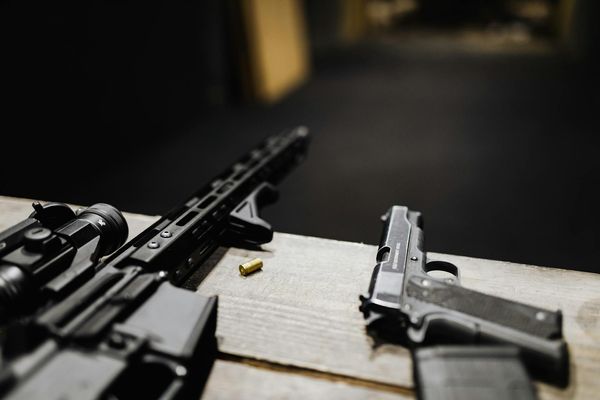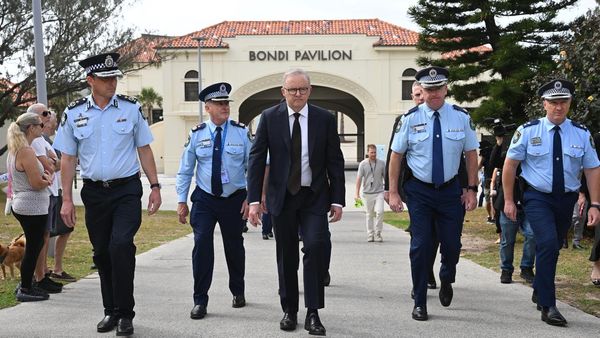
In 2009, while her husband and teenage children slept, April Balascio was often wide awake in their home in Jefferson, Ohio, jotting down the small towns she’d lived in as a child and trying to match them to their month and year.
This wasn’t as easy as it might sound. Her father had driven them all over the US – Ohio, Georgia, Florida, Arizona, Colorado, Wisconsin, Pennsylvania – in whatever vehicle they had at the time – an RV, a U-Haul truck, a camper, a school bus. They had set up home in farmhouses, mobile homes, tents, a barn. Sometimes Balascio completed a school year in one place; other times she didn’t, because her father would wake them at night, tell them to pack up, then off they’d go, no goodbyes, headed who knows where.
During those night-time online searches, Balascio would remember a place name, conjure a date in her mind, then tap them into her search bar with words such as “cold case” or “murder”. She had been doing this for about 18 months before she found something. “Cold case 1980 Watertown Wisconsin” took her to the so-called “sweetheart murders” of Kelly Drew and Timothy Hack, two 19-year-olds who had disappeared from a wedding reception at a venue called Concord House in August 1980. Balascio instantly remembered Concord House. Her father had worked there as a caretaker that summer – although, by the time the couple’s bodies had been found two months later, Balascio and her family had moved hundreds of miles east to Pittsburgh, Pennsylvania. In 2007, however, the case had been reopened because of DNA evidence – semen from Drew’s clothing – and there was a hotline for new leads. Balascio called it that night, barely expecting an answer, but a detective listened while she explained why Edward Wayne Edwards, her 75-year-old father, now living in Kentucky with his wife of more than 40 years, might be the man they were looking for.
“When I hung up, I thought: ‘What did I just do?’,” says Balascio. “Did I send that detective on a wild goose chase? I was doubting myself, berating myself. Was I a horrible person, to think this about my dad?”
As it turned out, she wasn’t. Edwards was not only responsible for the Watertown murders, but confessed to three others and hinted there were many more. For some true-crime conspiracy theorists, he is the US’s most prolific serial killer, the man behind the country’s most notorious unsolved crimes, from the 1960s “Zodiac killings” to the 1996 murder of JonBenét Ramsey in Colorado. Though Balascio believes none of this, she is firmly convinced that the number of her father’s victims totals more than five.
Listeners of the 2019 true-crime podcast The Clearing will remember some of Balascio’s story. Now it has been set out in far more detail in her book, Raised by a Serial Killer. It’s a fascinating account of a childhood that was many things – fun, wild and free, but dark and terrifying too. Edwards was monstrous, but also did loving things. This was a dad so excited by Christmas that he would fix a sleigh and a reindeer on the roof, transform whatever home they had into a wonderland and wake his kids in the night, because he couldn’t wait until morning to watch them unwrap the presents he’d chosen so carefully.
“I wanted the readers to go on the same rollercoaster that I was on, and have the same love/hate relationship with my dad that I had,” says Balascio. “That’s the thing about bogeymen. He was well-liked. He was the life of the party.” She believes this is partly why her father “was able to get away with these crimes for as long as he did”.
Edwards had met Balascio’s mother, Kay Lynn Hedderly, in the late 60s on a city bus in Akron, Ohio. She was 21, he was 35, on parole from prison. He’d had a hard start. Born to an unwed mother, he had spent much of his childhood in an orphanage where he had been brutally treated. In adolescence, he had graduated from bike theft to car theft, then criss-crossed America with a number of women, sometimes working in sales, but always scamming, robbing, and eventually hitting the FBI’s “10 most wanted” list. By the time Edwards met Hedderly, though, he claimed all this was behind him. They married and had five children very quickly – Balascio was the oldest. While her dad found work wherever they were (invariably stealing from his bosses and devising dubious ways to make more than his wage), he was also a motivational speaker, giving public talks about his transformation. He wrote a book about it too, Metamorphosis of a Criminal, which he handed out to new neighbours as a kind of calling card.
He wasn’t the loner we often associate with serial killers. He was the sun that his family revolved around. When Balascio, aged two, bit into an electric cord, ending up in hospital, it was Edwards who sat by her bedside, rocked her on his lap, eventually bringing her home and changing the bandage on her face each morning. Balascio says her dad was a cheerleader, coaching her in sport, officiating family games, driving her door to door to sell cookies so she could break state records in local fundraising initiatives.
She recalls her siblings stealing sweets from a pharmacy. “My dad marched them right back and made them apologise, and do chores for the guy who owned it to make amends,” she says. “My dad probably stole from that same pharmacy, but he truly did not want us to grow up like he did. I actually look back on my childhood with fondness,” she continues. “This is probably a coping mechanism, but I try not to think about all the negative.”
Her book describes multiple homes in enchanting places – neglected houses with stained glass windows, secret passages and spiral staircases on land covered in wild mint and fruit trees with chickens, dogs, cats and ponies. Her dad always picked up an entourage, threw parties and BBQs and big celebrations. But inside the home, Balascio says, he was also violent, controlling and abusive, with a hair-trigger temper. She says he broke her mother’s jaw twice, and also stabbed her – apparently because she’d finished all the crisps. They might be sitting down to dinner one minute, then picking it off the floor the next. Those magical houses they lived in often had no heating or running water and wherever they went, Balascio and her siblings were Edward’s band of child labourers, up ladders fixing the roof or on their knees scrubbing floors. More than once, he set fire to these places before moving on. It rarely ended well for the animals either – a dog hanged in a basement and a kitten hurled against a wall are just two grim examples. By 18, Balascio had had enough. She moved out, got a job and never lived with her family again.
She says she is “more understanding” of her mother now. “She was very controlled, very abused. In the 70s, they didn’t have the programmes for women that they do now. I’m sure she felt overwhelmed. She didn’t have a job, or a driver’s licence, she hadn’t worked outside the home, she had five children. What was she going to do?”
It wasn’t until the late 90s that Balascio came to strongly suspect her father of murder. As she and her siblings had grown up and gone, Edwards had fostered Dannie Boy, a friend of his youngest son. Dannie Boy idolised Edwards, calling him Dad and taking his surname. Edwards encouraged him to join the army, coached him through the entrance exam and signed him for the maximum military life insurance of $200,000 with himself as the beneficiary. When Dannie Boy’s body was found in a shallow grave near Edwards’s house, Edwards relocated with his wife from Ohio to Arizona. Dannie Boy had been shot in the head, but no arrests were made.
“I really believed my dad killed him, I just didn’t know how to prove it, and I was busy raising my family,” Balascio says. As her children grew, the questions about her father and her strange childhood grew too. By the time her own kids were teenagers, the dread that she felt when they were out, especially in the evening, seemed wildly disproportionate. All this led her to that childhood timeline, those internet searches and her father’s arrest.
DNA confirmed that Edwards was guilty of the Wisconsin murders and he began speaking of other murders too. By now, he was 75, morbidly obese and dependent on oxygen supplies and a wheelchair. He wanted the death penalty, which Wisconsin didn’t offer. Edwards never gave any credible explanation for why he killed Kelly Drew and Timothy Hack, but instead spoke of “other states” he could go to, starting with Ohio, which still had capital punishment. He confessed to the Ohio murder of Dannie Boy in 1996, and also of another young couple, Billy Lavaco and his girlfriend, Judith Straub, in 1977. Lavaco had been one of Edwards’s handymen and hangers-on. Edwards claimed that he’d murdered him because Lavaco had molested Balascio when she was eight years old. In fact, this was true – he had – but Balascio had no idea that her father knew. She hadn’t told anyone – nor did she know that Lavaco was dead.
“When the detectives told me, I vomited. I was in a tailspin, I had aches,” she says. “Every time I talked to a detective, I literally locked myself away in a room afterwards because I did not want my family to be burdened with how I might react. I remember going into the shower, wadding up a washcloth, sticking it in my mouth and screaming without making a sound. I did that shower trick many times.”
Edwards died of natural causes in prison in April 2011, a few months before his execution date. Balascio says she feels lighter now. “I feel like a big burden has been lifted that I didn’t even realise was there.” Meeting the father of Timothy Hack was especially healing. “Dave Hack came to my home with his wife, Judy, and I was a nervous wreck, not knowing what to expect,” she says. “They sat on my sofa and I sat on the floor at their feet. They told me all about Tim, the sweet stories of him growing up, and it was devastating.” Her voice breaks. “What if that had been one of my children? They wanted to know all about me and how I grew up. At the end we hugged. We stayed in touch. They’ve helped me more than I helped them.” Her book is dedicated to Dave and Judy Hack.
Now, Balascio says, the biggest thing she has had to come to terms with is how like her father she is in some ways. “Growing up, I was always told: ‘You’re just like your dad,’ and it’s true. My dad had a bad temper and so do I – but I also have a lot of his good and fun characteristics.
“The birthdays, the holidays, the outdoor activities he organised for the neighbourhood – I do those things. I learned a lot from him, too. I do electrical plumbing, tiling, I fix things, I’ve remodelled homes. Dad was very talented in that way. The salesmanship he taught us is the one thing all the siblings got and I really think that’s what helped us be successful in life. My children have it too.”
Balascio is divorced now, living alone in the Florida Panhandle on a smallholding that sounds similar to those from her childhood but much more wholesome. When we speak, there are 11 goldendoodle puppies running around in the room next door. “I’m an animal lover,” she says. “My dogs, my mama cat, the chickens, even the mice all somehow live together happily without chasing each other!”
Solving the puzzle of her childhood, making sense of those moonlight flits, still keeps Balascio awake at night. “I start investigating something and get consumed by it,” she says. “Then I hit dead ends and have to take a break.” She never saw Edwards after turning him in – although he did send his autograph from prison, adding that it would be worth something one day. (Balascio binned it.)
Still, she’s now able to say that she loves him. “For the longest time, I hated my dad but I can honestly say that I love him and I’m thankful for the things he did show me,” she says. “It’s choosing what I dwell on. I truly believe that he thought that he did the best he could. I’ll never make excuses for him. I know what he did and I can talk about that – but he was my dad.”
• Raised by a Serial Killer by April Balascio is published by HarperElement (£20). To support the Guardian and Observer, buy your copy from bookshop.theguardian.com. P&P charges may apply







